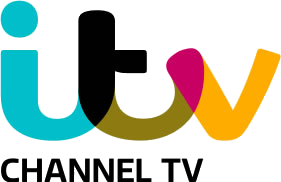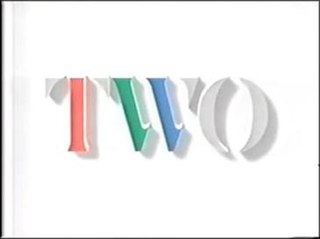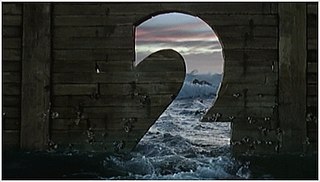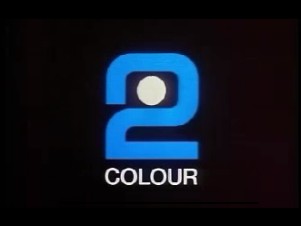
The Computer Generated 2 was an ident used by BBC2 between 16 June 1979 [1] and 30 March 1986. It was the first computer generated television station identification in the world.

The Computer Generated 2 was an ident used by BBC2 between 16 June 1979 [1] and 30 March 1986. It was the first computer generated television station identification in the world.
The ident package was launched in June 1979. The ident was aired through a solid-state computer device, not unlike the one used later for BBC1's Computer Originated World, built by BBC engineers, and designed by Oliver Elmes. The concept of the double striped '2' had been around for a long time: following the two television channels dropping corporate branding, a similar look was adopted by both channels featuring double striped numbers and BBC letters. The doubled striped '2' had been in use on programme promotions since 1977 and on holding slides since 1978.
The ident itself featured a cream, double striped numeral 2, with two orange lines either side going off screen. The whole ident had the illusion of three dimensions, with orange shadows, all on a black background. The ident would either remain static, scroll in from the left hand side or scroll out to the right. The form up ident was accompanied by an electronic fanfare, which was dropped in 1983. A subtitled programme would be accompanied by the additional caption below the numeral stating 'Ceefax 270' and later following a change of page 'Ceefax 888'.
The clock which accompanied this new look was located in the BBC2 Noddy room and comprised an orange clock face with counters of ever increasing thickness and with a 'polo' mint centre upon a black background. A plain orange and white 2D striped '2' logo was placed below the clock. The use of this old clock was due to the fact that the technology did not exist for an electronic timepiece, and would not until 1980, when an electronic timepiece was finally obtained for BBC2. This new electronic clock had no second hand judder and had a changed design, featuring two dashes at the quarter hours and single dashes elsewhere. The polo mint centre was abandoned in favour of a simple centre dot, and the 3D striped '2' logo adorned the bottom of the screen, although it was unanimated.
Promotional style wasn't uniform, but generally featured the striped '2' in the promotion in one form or another, whether at the beginning or appearing on the end slide. Programme slides featured a large white 2 with programme title overlaid the bottom of the image. This branding preceded the inception of the new ident by several months, with slides featuring the striped '2' from as early as late 1978. The BBC2 special Christmas ident of 1978, featuring rotating buglers, also incorporated this version of the striped '2'.
Regional variations of BBC2 featured the region name below the 2.
A variation of the look was introduced on 19 September 1983 and was used during the Daytime on 2 strand. It featured the ident with an orange gradient background.
Some special versions were produced for public celebrations such as Christmas:
The ident was reused in early 2005 for the opening continuity announcement in the second series of the period comedy Look Around You .
It was reused again in May 2010, with a new soundtrack, as part of BBC Two's "80's Season", to celebrate events and features from the decade.
It was then brought back twice in October 2012, with no soundtrack. It was shown in Northern Ireland on the 10th of October 2012 to mark the shutdown of analogue transmissions in the area and shown nationally during the final evening hours of 21 October at 4:35am to lead into the final edition of Pages From Ceefax after 38 years on-screen across the BBC.
On 7 October 2013, this (and its Christmas '79, '84 & '85 ident in England and Northern Ireland), along with others was brought back for BBC Two's "Afternoon Classics" block and last appeared in December 2016.
It made its final appearance in 2017 to introduce the 80s-set comedy White Gold .

ITV Channel Television, previously Channel Television, is a British television station which has served as the ITV contractor for the Channel Islands since 1962. It is based in Jersey and broadcasts regional programme for insertion into the network ITV schedule. Until November 2011, Channel Television was one of four ITV companies independent from ITV plc alongside the two STV regions in Scotland and UTV in Northern Ireland. The station has been owned by ITV plc since 2012 and the licence was transferred to ITV Broadcasting Limited in March 2017.

SVT1 is the primary television station of the Swedish public service broadcaster Sveriges Television in Sweden.

The BBC One "Rhythm & Movement" idents were a set of on-screen channel identities designed by Lambie-Nairn and used on BBC One from 29 March 2002 to 7 October 2006. They replaced the balloon idents, and spelled the end of the much recognised globe identity by the BBC, which had been used in various ways since 1963.

Noddy was a camera system used for generating idents for the BBC One and BBC Two television channels from late 1963 to February 1985.
The history of BBC television idents begins in the early 1950s when the BBC first displayed a logo between programmes to identify its service. As new technology has become available, these devices have evolved from simple still black and white images to the sophisticated full colour short films seen today. With the arrival of digital services in the United Kingdom, and with them many more new channels, branding is perceived by broadcasters to be much more important, meaning that idents need to stand out from the competition.

The Computer Originated World (COW) was the method of creating the BBC1 symbol that was used between 18 February 1985 and 16 February 1991. It was later used by the international, commercial television service BBC World Service Television from its launch until 26 January 1995.

The BBC Two '1991–2001' idents were broadcast from 16 February 1991 until 19 November 2001, and again from 9 July 2014 until 26 September 2018, on BBC Two in the United Kingdom. The idents, which consisted of a sans-serif '2' in Gill Sans, accompanied by the colour viridian, were created by branding agency Lambie-Nairn, who also created the Channel 4 logo.

The "Virtual Globe" was the method of creating the BBC1 symbol that was used between 16 February 1991 and 4 October 1997.
The logo of the BBC has been a brand identity for the corporation and its work since the 1950s in a variety of designs. Until the introduction of a logo in 1958, the corporation had relied on its coat of arms for official documentation and correspondence, although this crest rarely appeared onscreen. With the increased role of television for the BBC in the 1960s, particularly after the foundation of ITV, the corporation used its logo to increase viewer familiarity and to standardise its image and content. The logo has since been redesigned a number of times, most recently in 2021 with the BBC blocks, a logo designed to work across media. From 1958, there have been six different BBC logos. The first logo of the network was used from 1958 to 1963, the second from 1963 to 1971, the third from 1971 to 1992, the fourth from 1988 to 1997, the fifth from 1997 to 2021, while the sixth and current logo was adopted in October 2021.

The BBC TwoPersonality idents were a set of idents used on BBC Two from 19 November 2001 until 18 February 2007. The idents were produced by the Lambie-Nairn branding agency, who had created the previous look. The idents feature an ivory sans serif white '2' in a yellow environment and performing a variety of tasks, and a purple boxed BBC Two logo.

The BBC Two "Two" ident was the station identification used on BBC2 between 30 March 1986 and 16 February 1991. It was the last non-corporate look for the channel, and the only look until 2018 that did not feature a numeral '2' in the design.
BBC Schools, also known as BBC for Schools and Colleges or BBC Education, is the educational programming strand set up by the BBC in 1957, broadcasting a range of educational programmes for children aged 5–16. From launch until June 1983, programming was based on BBC1 during the daytime, apart from coverage of major news events which saw the programmes shifted to BBC2. In September 1983, programming was transferred permanently to BBC2 freeing BBC1 to develop its own daytime schedule. The strand, named Daytime on Two, remained on BBC Two until March 2010, later supplemented by the 'Class TV' strand on CBBC.
BBC One used a number of different idents from the time of the station launch on 2 November 1936 until the station took on the Mirror Globe Idents on 15 November 1969.

The Window on the World idents were a set of idents used by BBC Two from 18 February 2007 until 13 November 2014. They were created by Abbott Mead Vickers BBDO and produced by Red Bee Media. The idents featured a number 2 cut out of, or made out of parts of the everyday environment.
The Striped 2 was an ident used by BBC2 between 28 December 1974 and 16 June 1979. The ident featured a numeral 2 made out of horizontal lines.

The Cube 2 was an ident used by BBC Two between 2 December 1967 and 28 December 1974. It featured a stylised "2" that rotated on screen.

The Launch ident was a television station identification used by BBC Two between their launch night in 1964 and the introduction of colour in 1967.
Throughout the years, Children's BBC, and later CBBC and CBeebies, have used a number of different identities. The branding of the stranded service is distinctive both in the past and at present.
The presentation and the identities of the BBC News channel in the UK alongside its international counterpart and the BBC Parliament coverage channel use specific identities that demonstrate their remit and purpose.
This is a timeline of the broadcasting of schools programmes on television in the UK.